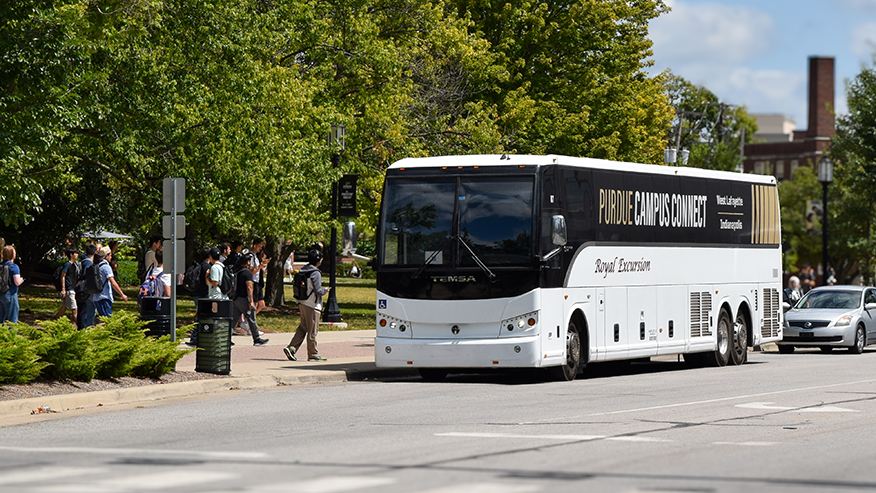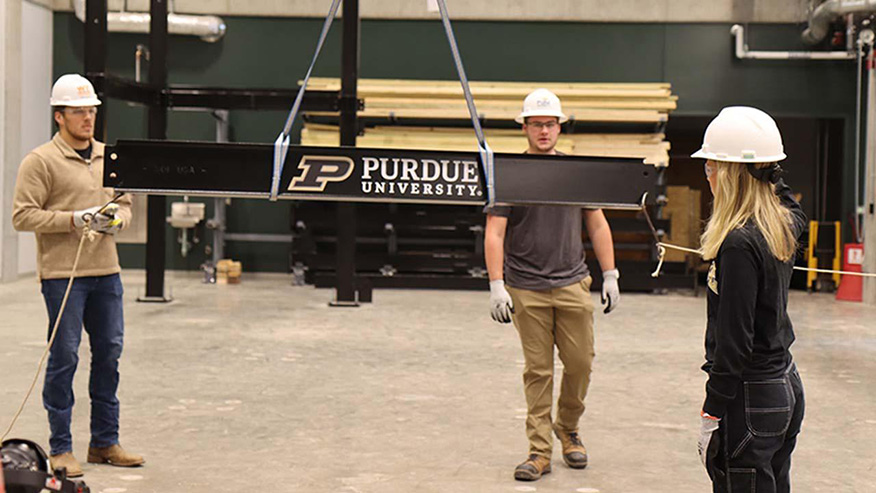Quantum Research Sciences receives U.S. Air Force’s first Quantum Computing Phase III contract
Quantum computing delivers more accurate inventory forecasting

Quantum Research Sciences has received a $2.5 million, three-year Phase III Small Business Technology Transfer contract from the U.S. Air Force to deliver the Department of Defense’s first operational, production-level quantum computing software. QRS personnel are (left to right) AJ Wildridge, CTO and Purdue University doctoral student; CEO Ethan Krimins; and Andreas Jung, COO and Purdue University associate professor of physics and astronomy. (Purdue Research Foundation photo/Jennifer Mayberry)
Purdue-connected software company Quantum Research Sciences (QRS) has received a $2.5 million, three-year Phase III Small Business Technology Transfer (STTR) contract from the U.S. Air Force to deliver the Department of Defense’s first operational, production-level quantum computing software.
CEO Ethan Krimins said the company has used a quantum computer to accurately identify optimal inventory levels, including for parts with sporadic or infrequent demand. The Air Force will be the first customer, but the software’s capabilities will allow it to be utilized throughout the DOD.
Headquartered in Lafayette, QRS is a Purdue Innovates client company and an affiliate company of the Purdue Quantum Science and Engineering Institute. QRS collaborates on the quantum computer software with Andreas Jung, associate professor of physics and astronomy in Purdue University’s College of Science, and the Jung Research Group, where AJ Wildridge carries out his doctoral research.
Supply chain challenges
A majority of the world’s inventory, whether it be in the military or private industry, sits on the shelf because user demand is not easy to predict. The Air Force considers much of its inventory unforecastable, and the consequence is that too many or too few parts are in the supply chain.
“Not having adequate inventory puts stress on industrial and supplier sourcing processes, while excess inventory has costs associated with storage, security, maintenance, theft and design obsolescence,” said Curtis Mears, director of the USAF 418th Supply Chain Management Squadron.
Most government agencies, military organizations and commercial corporations employ forecasting technology that predicts future inventory levels based on historical demand. The chances are slim that the prediction will be accurate.
“At best, a supply chain forecast is an educated guess; at worst, it is a wild guess,” Krimins said. “For organizations, the consequence is tens of millions of dollars tied up in inventory that can’t be sold, utilized or liquidated.”
A quantum software solution
QRS has turned the problem of supply chain inventory management into an optimization scenario, something that quantum computers are uniquely capable of solving.
“Quantum computers are excellent at optimization: quickly identifying the most efficient solution in a complex situation,” said Chris McCorkle, USAF 418th Data Science and Analysis Flight Chief. “Looking at the supply chain management problem as an optimization scenario allows us to harness quantum computers to determine how many items should be on a shelf more accurately than a classical computer can.”
The results? “QRS quantum computer software is achieving a 28% improved accuracy over classical computers,” Krimins said.
Value isn’t just in determining how many items should be in inventory.
“An optimal solution includes three answers: how many parts are needed, when they are needed and how they get there,” Krimins said. “The cost of our quantum software quickly pays for itself by providing organizations with the data to answer these questions without guessing or estimating.”
Contracting with the U.S. Air Force
Mears said, “The Phase III contract with the U.S. Air Force builds upon three years of effort with this technology.”
“We designed the software under a USAF Phase I STTR. It was developed into a prototype during Phase II,” Krimins said. “The culmination of our work, moving from prototype to real-world production, occurs in Phase III. The process has been a collaborative one from the start, and it would not have been possible without support from the Air Force and Purdue.”
About Quantum Research Sciences
Quantum Research Sciences (QRS) is an American technology company focused on the discovery, development and delivery of practical quantum software. QRS created the DOD’s first operational quantum software and is working toward new quantum software applications every day. For more information on QRS, visit https://quantumresearchsciences.com/.
About Purdue University
Purdue University is a public research institution with excellence at scale. Ranked among top 10 public universities and with two colleges in the top four in the United States, Purdue discovers and disseminates knowledge with a quality and at a scale second to none. More than 105,000 students study at Purdue across modalities and locations, with 50,000 in person on the West Lafayette campus. Committed to affordability and accessibility, Purdue’s main campus has frozen tuition 13 years in a row. See how Purdue never stops in the persistent pursuit of the next giant leap, including its first comprehensive urban campus in Indianapolis, the new Mitchell E. Daniels, Jr. School of Business, and Purdue Computes, at https://www.purdue.edu/president/strategic-initiatives.
About Purdue Innovates
Purdue Innovates is a unified network at Purdue Research Foundation to assist Purdue faculty, staff, students and alumni in either IP commercialization or startup creation. As a conduit to technology commercialization, intellectual property protection and licensing, startup creation and venture capital, Purdue Innovates serves as the front door to translate new ideas into world-changing impact.
For more information on licensing a Purdue innovation, contact the Office of Technology Commercialization at otcip@prf.org. For more information about involvement and investment opportunities in startups based on a Purdue innovation, contact Purdue Innovates at purdueinnovates@prf.org.
Writer/Media contact: Steve Martin, sgmartin@prf.org
Source: Ethan Krimins, ekrimins@quantumresearchsciences.com



